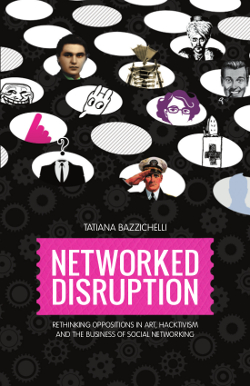
Networking. The Net as Artwork
 By Tatiana Bazzichelli
By Tatiana Bazzichelli
Preface by Derrick De Kerckhove
A reconstruction of the history of artistic networking in Italy and of the Italian hacker community from the 1980s to date.
Download the book:
Language: English | Pages: 336. Download (PDF, 3.10 MB).
Language: Italian | Pages: 317. Download (PDF, 3.9 MB)
Buy the book: www.bod.com
Abstract:
Networking means to create nets of relations, where the publisher and the reader, the artist and the audience, act on the same level. The book is a first tentative reconstruction of the history of artistic networking in Italy, through an analysis of media and art projects which during the past twenty years have given way to a creative, shared and aware use of technologies, from video to computers, contributing to the creation of Italian hacker communities.
The Italian network proposes a form of critical information, disseminated through independent and collective projects where the idea of freedom of expression is a central theme. In Italy, thanks to the alternative use of Internet, during the past twenty years a vast national network of people who share political, cultural and artistic views has been formed.
The book describes the evolution of the Italian hacktivism and net culture from the 1980s till today. It builds a reflection on the new role of the artist and author who becomes a networker, operating in collective nets, reconnecting to Neoavant-garde practices of the 1960s (first and foremost Fluxus), but also mail art, Neoism and Luther Blissett. A path which began in BBSes, alternative web platforms spread in Italy through the 1980s even before the Internet even existed, and then moved on to Hackmeetings, to Telestreet and networking art by different artists such as 0100101110101101.ORG, [epidemiC], Jaromil, Giacomo Verde, Giovanotti Mondani Meccanici, Correnti Magnetiche, Candida TV, Tommaso Tozzi, Federico Bucalossi, Massimo Contrasto, Mariano Equizzi, Pigreca, Molleindustria, Guerriglia Marketing, Sexyshock, Phag Off and many others.
Preface by Derrick De Kerckhove. Epilogue by Simonetta Fadda.
Translation: Helen Pringle and Maria Anna Calamia, revised by Grace Wright.
Layout and front cover by Jonas Frankki.
Cover image: Giovanotti Mondani Meccanici by Antonio Glessi-Andrea Zingoni, published in “Frigidaire” issue 42, May 1984, Primo Carnera Edition.
Copyright © Italian edition 2006, costlan editori s.r.l., Milan.
Copyright © English edition 2008, Digital Aesthetics Research Center, Aarhus University, and the author.
The book is published under the GNU Free Documentation License, Version 1.3, November 2008.
More info about the book: English | Italian.
 Tatiana Bazzichelli – Networking Art
Tatiana Bazzichelli – Networking Art
